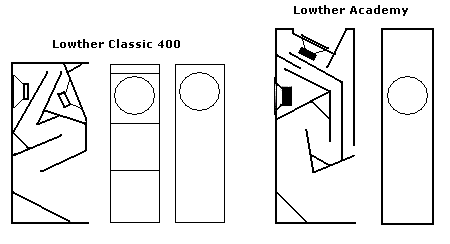is this a form of rear load horn scoop?
- deadbeat
-

- Offline
- Platinum Member
-

I agree with the granite cabinet not resonating at LF, most of us here have thrown rocks around, including granite.
I can't supply any 'vindicating' context, but it was copied from here. I linked this previously in the thread.
fullrangedriver.com/forum/viewtopic.php?id=91&p=1
I can't find his email, but if you were interested, you could find it. I am not a member of that forum. Ron designs his horns in a very interesting way.
'Audiophile' forums...I find that the definition of an 'audiophile' varies everywhere. I sold stuff to some 'audiophiles' a while back that the 'audiophiles' in such forums (like diyaudio and fullrangedriver) would never dream of buying. I go on such forums because information is present, and my view is that no matter the source, info is info and it is present (eg the ongoing discussion about the relationship between bandpass and tapped horn alignments, and the factor that is missing in most simulations, on diyaudio).
Beranek\'s law
\'bits of ply round a driver\'
Please Log in or Create an account to join the conversation.
- deadbeat
-

- Offline
- Platinum Member
-

Beranek\'s law
\'bits of ply round a driver\'
Please Log in or Create an account to join the conversation.
- jake_fielder
-

- Offline
- Elite Member
-

- Posts: 170
- Thank you received: 0
Please Log in or Create an account to join the conversation.
- deadbeat
-

- Offline
- Platinum Member
-

Jake_Fielder wrote: wow, that second one is crazy! do you have any info on it?as someone once said:"info is info"
yes I do. Will dig up...you have to figure them out.
www.lowtherloudspeakers.com/homeindex.html
Click on the 'enclosures to build' link and you will come to a page with some crazy designs.
fullrangedriver.com/forum/viewtopic.php?id=1852
Nother one with subjective opinions.
Can't find much on their design etc though. Lowther clearly have a concept with it though. They've stuck with the basic design principle for ages...some cabinets are hit, some are miss.
Mykey!
Have you heard of 'Feastrex'? Go and get shocked by their prices....
But info is info!
Beranek\'s law
\'bits of ply round a driver\'
Please Log in or Create an account to join the conversation.
- deadbeat
-

- Offline
- Platinum Member
-

This is not meant to be a detailed piece on the acoustics involved at all. It's a piece I've tried to tailor for relevance to our interests (ummm...sound reinforcement?).
In case you didn't read the earlier links (the ones on the detailed acoustics involved etc), I'll quickly explain why baffle step compensation is used.
The gain you get from positioning a speaker on an infinite baffle (An infinite wall - 1/2 space) as compared to a speaker in mid air (full space) is 6dB. As most speakers have finite baffles, there is a gradual 6dB step in frequency response, the highs being louder. This is perceived as a lack of bass - as speakers are usually modeled in 1/2 space unless selected not so.
Let's deal with size now - we have established that there will be a transition of 6dB in any baffle that is not infinitely large or infinitely small. But what's a quick rule of thumb to find this out?
John Murphy's calculation:
</font><blockquote>
f(3) = 115/W(
(where W(
This gives us the midpoint of the 6dB transition.
Now let's think about shape: look at olson's page 23 and accompanying sheets.
The sphere has the best transition curve (hear me Mykey?). The reason for the smoothness is that the diameter of the curve approaches the wavelength of the frequency - then baffle step has pretty much no effect.
The other boxes all relate to each other - by comparing graphs, you can see that the absolute worst case is having a driver in the middle of a cylinder's face. The transition is better when the driver has varying lengths from it to the edge of a baffle and when the face is beveled, once charts are compared.
What do we do about all of this nonlinearity? Why, compensate for it of course. Now I'm really not going to go into the electronics or circuits involved too much, as it's all explained on John Murphy (True Audio's site) - the way he does it is:
</font></font>Once the diffraction loss is known it is possible to design a simple electrical network
that will exactly mirror the spherical diffraction loss and restore the lost bass to a
speaker system. Loudspeaker designers have traditionally compensated for the diffraction
loss by reducing the level of the tweeter and making other adjustments in the crossover.
The method I propose is to design for half space but then do a precise mirror image
compensation for the diffraction loss by way of an R-L network wired in series with the
(impedance compensated) speaker. Alternately, the diffraction loss can be compensated at
line level with a simple R-R-C network. Line level correction would reduce the requirement
for the large inductors typically needed for a speaker level compensation network.
</font>
Some do BSC by just padding down a tweeter, but unless the 3dB point is around the crossover frequency, then this circuit is a bit nicer in my opinion.
After that, he goes on with an example and some circuit diagrams. Importantly, baffle step can be compensated either built in to the passive crossover or at line level, and be tackled in many ways. Rod Elliot's circuit allows for a variable resistor to change the 6dB slope to compensate for the room boosting LF and making the 6dB transition less steep.</font></font>
Loudspeaker manufacturers tend to publish driver response data on a virtual infinite baffle (that is, it is so big that at the range they test it in, the low frequency limits of the driver itself will lend itself to 1/2 space operation when measured. Other times the manufacturer will tell you what situation they test in - some test in full space, hanging the driver in a chamber, etc.
So is there a precise way to approach this? A program or something?
Yes - look at Tolvan's The Edge, linked earlier.
Again - the link provides most of the info on how to use it, so I'm not going to do an in depth analysis.
You graphically draw your baffle and driver and microphone - the program's graphical interface regarding this is very good and intuitive - and then it simulates the response. Then you create the network being used on it (it can calculate passive and line level solutions) - it suggests values to help you, and run the sim again to see how it affects the response.
This is quite useful for cabs that will cover quite a decent frequency range - not 30-80hz bass bins really - I'm thinking of wide range midtops.
A few sessions of prototyping away and a completed passive crossover and speaker with this magical 'baffle step' technology is yours for the taking! [img]smileys/smiley36.gif[/img]
Have fun playing around with this new tool.
Beranek\'s law
\'bits of ply round a driver\'
Please Log in or Create an account to join the conversation.
- mykey
-

- Offline
- Elite Member
-

- Posts: 167
- Thank you received: 0
yes I came across them on fullrangedriver.com a while back, after doing some research for my sphere'sDeadbeat wrote:
Jake_Fielder wrote: wow, that second one is crazy! do you have any info on it?as someone once said:"info is info"
yes I do. Will dig up...you have to figure them out.
www.lowtherloudspeakers.com/homeindex.html
Click on the 'enclosures to build' link and you will come to a page with some crazy designs.
fullrangedriver.com/forum/viewtopic.php?id=1852
Nother one with subjective opinions.
Can't find much on their design etc though. Lowther clearly have a concept with it though. They've stuck with the basic design principle for ages...some cabinets are hit, some are miss.
Mykey!
Have you heard of 'Feastrex'? Go and get shocked by their prices....
But info is info!
www.feastrex.com/
they're come in ya short's kinda drivers
Anyone got any ply?
Please Log in or Create an account to join the conversation.
- deadbeat
-

- Offline
- Platinum Member
-

Ron Clarke:
On the subject of reflective surface:
During my study of
centerline segregration of carbon steel plates i came to the
realization that a smooth surface developed a more coherent wave
reflection than a rough surface on a frequency dependant curve. A
smooth surface (Pong reflector) developed a more near mathematical loss
in energy than a rough surface. The energy loss was an exponential
curve based on the RMS (root mean square) and the frequency.
Conclusion: any energy reflection of a wave will develop a loss in
energy beyond the difference in impedance mismatch due to the spreading
of energy due to the wave front being distorted (however minor) due to
an irregualr surface. A 30 hz wave losses energy but to a lesser degree
than a 200 hz wave upon encountering a lambertien (sp,rough surface)
upon reflection.
I have encountered a lot of negetavie feedback ,
in the past, for smooth bends on my designs. I am sorry, but acoustical
physics states for the miniimul loss in effficency of the energy
transferred, smooth radi should be incorporated for any bends in the
sound path/expansion.
ron
Beranek\'s law
\'bits of ply round a driver\'
Please Log in or Create an account to join the conversation.
- deadbeat
-

- Offline
- Platinum Member
-

Beranek\'s law
\'bits of ply round a driver\'
Please Log in or Create an account to join the conversation.
- deadbeat
-

- Offline
- Platinum Member
-

www.diyaudio.com/forums/showthread/t-69053.html
Modelling hi fi rear loaded horns - specifically the Lowthers mentioned earlier:
www.geocities.com/dmitrynizh/pm6a-hornresp.htm#horns
I'll stick anything in layman's terms if requested.
sks01, you may be interested in this link as well as the others:
www.speakerplans.com/FORUM/forum_posts.asp?TID=9518&KW=bvr&PN=1
Beranek\'s law
\'bits of ply round a driver\'
Please Log in or Create an account to join the conversation.
- sks01
-

- Offline
- Premium Member
-

- Posts: 154
- Thank you received: 0
much obliged for the links ill be off searching through them for some time i think...
Edited by: sKs01
do it for the love of the music
Please Log in or Create an account to join the conversation.

